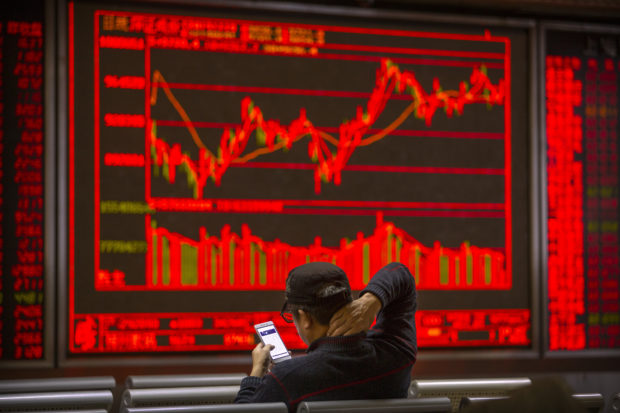BANGKOK — Shares in Asia failed to hold onto opening gains on Thursday, skidding further after the latest selloff on Wall Street.
Stocks fell in Tokyo, Sydney, Hong Kong and Seoul in early trading Thursday. Investors are in search of cash as fears of a prolonged coronavirus-induced recession take hold.

Japan’s Nikkei 225 index gave up 0.7% to 16,5602.26, while in South Korea, the Kospi sank 6.5% to 1,487.85. Hong Kong’s Hang Seng index slipped 4% to 21,397.56 and the Shanghai Composite index shed 1.9% to 2,676.79.
Australia’s S&P ASX/200 declined 2.3% to 4,840.80. Shares also fell in Southeast Asia.
The losses followed a more than 1,300 point, or 6.3%, decline Wednesday in the Dow Jones Industrial Average, which has now lost nearly all of its gains since President Trump’s inauguration. The Dow closed at 19,898.92.
Futures for the Dow and the S&P 500 were both down 1.5% early Thursday Asia time.
New York’s losses deepened after a temporary halt was triggered in the early afternoon. Even prices for investments seen as very safe, like longer-term U.S. Treasurys, have fallen as investors rush to raise cash.
The New York Stock Exchange said Wednesday it will temporarily close its iconic trading floor in lower Manhattan and move to all-electronic trading beginning Monday as a precautionary step amid the coronavirus outbreak.
Signs that the outbreak’s impact will be far reaching and prolonged have undermined efforts to staunch the bloodletting on the markets as investors find themselves without their usual safe havens from risk.
The price of oil fell 24% on Wednesday, dropping below $21 per barrel for the first time since 2002. By early Thursday, they had recovered some losses, with U.S. crude up 7.4% at $21.88 per barrel.
Brent crude, the international standard, was up 59 cents at $25.47 per barrel.
Markets have been incredibly volatile for weeks as Wall Street and the White House acknowledge the rising likelihood that the outbreak will cause a recession. The typical day this month has seen the U.S. stock market swing up or down by 4.9%. Over the last decade, it was just 0.4%.
The Dow, now at its lowest level since 2016, had surged more than 5% on Tuesday after Trump promised massive aid to the economy, but the number of infections keeps climbing, topping 200,000 worldwide.
The S&P 500, which dictates how 401(k) accounts perform much more than the Dow, is down nearly 30% from its record set last month, though it’s still above its level on Election Day 2016.
The S&P 500’s slide was so sharp that trading was halted for 15 minutes Wednesday. The losses deepened after trading resumed. The S&P 500 recouped some losses to close 5.2% lower, at 2,398.10.
The Nasdaq composite index shed 4.7% to 6,989.84.
As big swaths of the economy retrench while much of society comes to a halt in an attempt to slow the spread of the virus, investors have clamored for Congress, Federal Reserve and other authorities around the world to support the economy until it can begin to reopen.
They got a big shot of that Tuesday, when the Trump administration briefed lawmakers on a program that could surpass $1 trillion and the Fed announced its latest moves to support markets.
Investors are struggling with uncertainty about how badly the economy is getting hit, how much profit companies will make and how many companies may go into bankruptcy due to a cash crunch.
“It’s, it’s a very tough situation,” Trump said at a news conference, during which losses for stocks accelerated. “You have to do things. You have to close parts of an economy that six weeks ago were the best they’ve ever been…. And then one day you have to close it down in order to defeat this enemy.”
“The volatility is going to be here to stay,” said Brian Nick, chief investment strategist at Nuveen. “It’s about the virus and not the economic response.”
Even prices for longer-term U.S. Treasurys, which are seen as some of the safest possible investments, fell as investors sold what they could to raise cash. That pushed the yield on the 10-year Treasury sharply higher, to 1.24%. It had recently dropped below 1% for the first time ever.
Gold also fell, though Thursday it was up $5.20 per ounce at $5,483.10.
Investors are selling their highest-quality bonds to raise cash, thinking they will be the easiest to sell and will hold up the best. That’s paradoxically undercutting their prices further.
For most people, the coronavirus causes only mild or moderate symptoms, such as fever and cough, and those with mild illness recover in about two weeks. Severe illness including pneumonia can occur, especially in the elderly and people with existing health problems, and recovery could take six weeks in such cases.
All the uncertainty has pushed many people toward safety. Last month, investors pulled $17.5 billion out of stock mutual funds and exchange-traded funds, even though stocks set all-time highs in the middle of the month. Money-market funds, meanwhile, drew $25.5 billion, according to Morningstar.
The turmoil is also rocking foreign exchange markets as investors scrounge for U.S. dollars.
The dollar was at 109.20 Japanese yen Thursday, up from 108.07 late Wednesday. The euro fell to $1.0899 from $1.0913.

